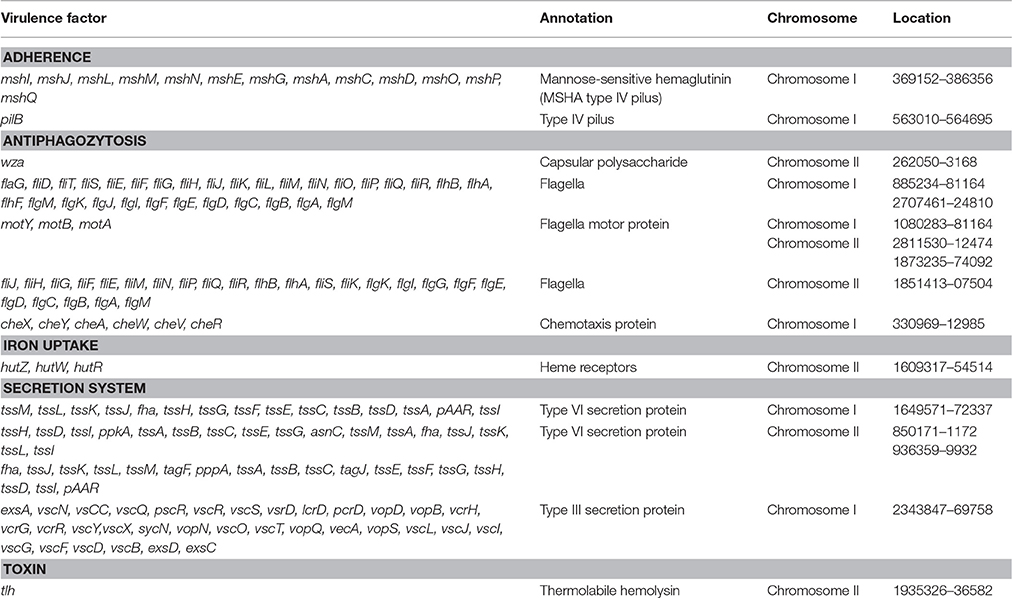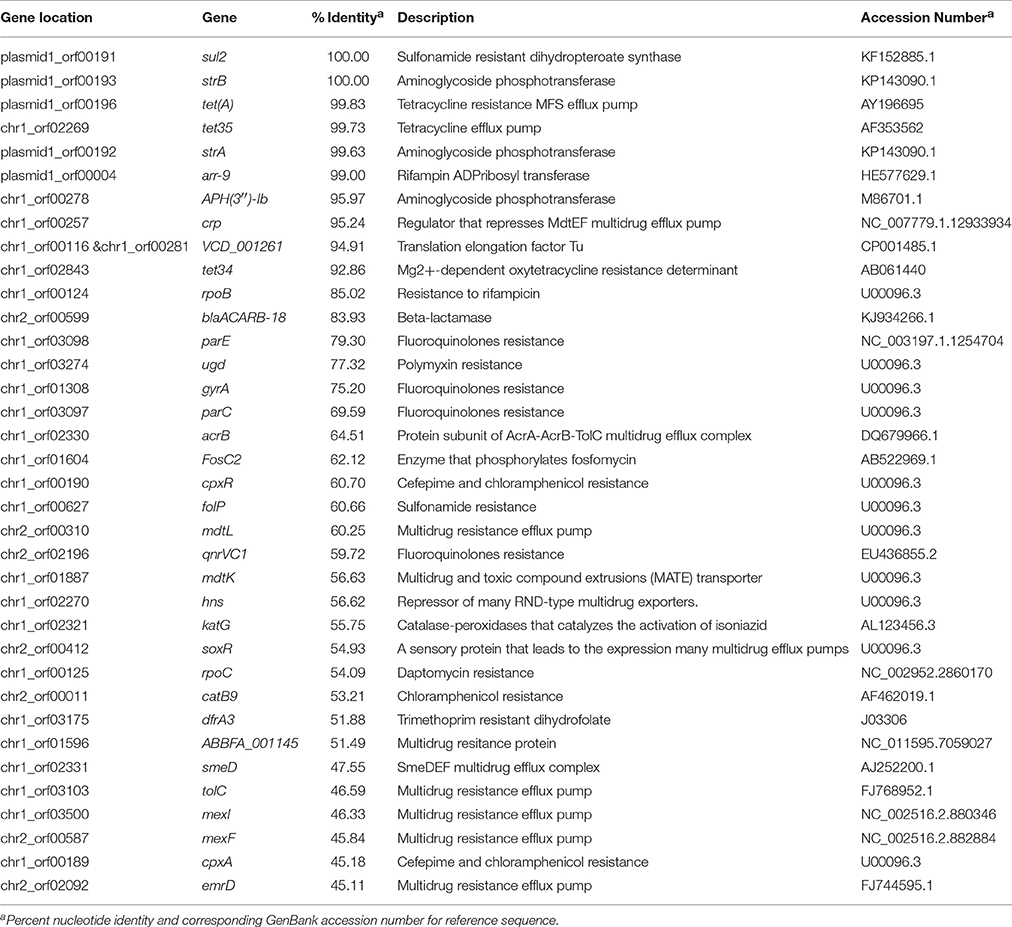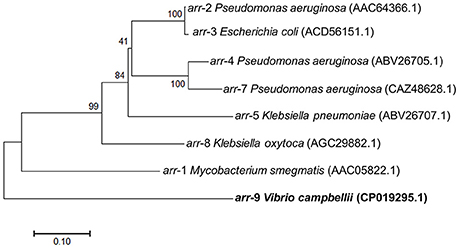- 1Institute of Marine Biology, College of Oceanography, Hohai University, Nanjing, China
- 2Department of Food Science and Technology, University of California, Davis, Davis, CA, United States
- 3Key Laboratory of Tropical Marine Bio-resources and Ecology, Guangdong Provincial Key Laboratory of Applied Marine Biology, South China Sea Institute of Oceanology, Chinese Academy of Sciences, Guangzhou, China
Vibrio spp. are the most common pathogens for animals reared in aquaculture. Vibrio campbellii, which is often involved in shrimp, fish and mollusks diseases, is widely distributed in the marine environment worldwide, but our knowledge about its pathogenesis and antimicrobial resistance is very limited. The existence of this knowledge gap is at least partially because that V. campbellii was originally classified as Vibrio harveyi, and the detailed information of its comparative genome analysis to other Vibrio spp. is currently lacking. In this study, the complete genome of a V. campbellii predominant strain, LMB29, was determined by MiSeq in conjunction with PacBio SMRT sequencing. This genome consists of two circular DNA chromosomes and four megaplasmids. Comparative genome analysis indicates that LMB29 shares a 96.66% similarity (average nucleotide identity) with the V. campbellii ATCC strain BAA-1116 based on a 75% AF (average fraction) calculations, and its functional profile is very similar to V. campbellii E1 and V. campbellii CAIM115. Both type III secretion system (T3SS) and type VI secretion system (T6SS), along with the tlh gene which encodes a thermolabile hemolysin, are present in LMB29 which may contribute to the bacterial pathogenesis. The virulence of this strain was experimental confirmed by performing a LDH assay on a fish cell infection model, and cell death was observed as early as within 3 h post infection. Thirty-seven antimicrobial resistance genes (>45% identity) were predicted in LMB29 which includes a novel rifampicin ADP ribosyltransferase, arr-9, in plasmid pLMB157. The gene arr-9 was predicted on a genomic island with horizontal transferable potentials which may facilitate the rifampicin resistance dissemination. Future researches are needed to explore the pathogenesis of V. campbellii LMB29, but the availability of this genome sequence will certainly aid as a basis for further analysis.
Introduction
Vibrio campbellii is a Gram-negative bacterium that has been found widely distributed in marine associated aquatic environments (Thompson et al., 2004). This bacterium was once classified as non-pathogenic, non-luminescent Vibrio spp. probably because it was misidentified with Vibrio harveyi for years (de la Pena et al., 2001; Lin et al., 2010). Indeed, studies indicate this bacterium is an important pathogen that contributes to luminescent disease in farmed shrimp (Gomez-Gil et al., 2004; Phuoc et al., 2008; Wang L. P. et al., 2015), causes mortality in reared fish and shellfish (Thompson et al., 2004), and may also be involved in the process of coral bleaching (Thompson et al., 2005).
The red drum (Sciaenops ocellatus), also known as channel bass, spottail bass, or redfish, is originally distributed in the Atlantic Ocean and the Gulf of Mexico. This species is commercially valuable sciaenid with demonstrated suitability for mariculture, and has become one of important cage-aquaculture fish since its introduction into China in 1995 (Shao, 2010). Vibriosis are a major obstacle for healthy and sustainable development of mariculture in China. One predominant strain V. campbellii LMB29, with a multi-drug resistance phenotype (ampicillin, amoxicillin, rifampicin, tetracycline, streptomycin, oxacillin, lincomycin, teicoplanin, vancomycin), was isolated from a cage-cultured red drum in Shenzhen, China (2012) and was suspected to contribute to serious skin ulcer of the fish. Scientific researches are needed to study its pathogenesis to reduce the economic losses.
In this study, we characterized the complete genome sequences of V. campbellii strain LMB29 to investigate its virulence and antimicrobial resistance. Multiple virulence factors were identified in this strain, including a gene encoding the thermolabile hemolysin (tlh) which is normally considered a significant molecular marker for pathogenic Vibrio parahaemolyticus (Gutierrez West et al., 2013). In addition to type III secretion system (T3SS), a recently characterized type VI secretion system (T6SS) (Ho et al., 2014) is also present in this strain which suggests that LMB29 is virulent. Its virulence was further confirmed by using a LDH assay on a fish cell infection model. Thirty-seven antimicrobial resistance genes (>45% identity) were predicted in this strain which includes a novel rifampicinn ADP ribosyltransferase, arr-9, in plasmid pLMB157. The gene arr-9 was predicted on a genomic island and it is the first report about this gene in a transmissible plasmid from Vibrio spp. The availability of this genome sequences along with our preliminary findings of V. campbellii LMB29 will aid as a basis for further analysis of pathogenesis and antimicrobial resistance of Vibrio species in marine aquaculture system.
Materials and Methods
Genome DNA Preparation and Whole Genome Sequencing
Vibrio campbellii LMB29 was isolated from skin ulcer sample of cage-cultured red drum in Shenzhen, China by 2012. Briefly, diseased tissue mixtures were plated onto thiosulphate citrate bile salts sucrose (TCBS) agar for incubation under 30°C. 24–36 h later, morphologically uniform colonies of Vibrio were passaged onto fresh media to obtain pure colonies. The strain identity of individual isolate was confirmed with optimized multilocus sequence analysis (MLSA) (Gabriel et al., 2014). The predominant strain, V. campbellii LMB29, was grown in TSB media at 30°C and its genomic DNA was extracted by using the Cetyltrimethyl Ammonium Bromide (CTAB) method with minor modification (Healey et al., 2014). The quantity and quality of genomic DNA were assessed by using a Qubit 2.0 Fluorometer (Thermo Scientific, USA) and a NanoDrop 2000 Spectrophotometer (Thermo Scientific, USA), respectively. The whole genome sequencing was performed by a commercial vendor (Personalbio, Shanghai, China) by using Illumina MiSeq (400 bp inserts library with 251 bp paired-end sequencing; Illumina, San Diego, CA, USA) and PacBio RS II platform (10 kb inserts library; Pacific Biosciences, Menlo Park, CA, USA).
Genome Assembly and Annotation
The trimmed sequences from Illumina MiSeq were assembled using Newbler version 2.8 (454 Life Sciences, Branford, CT, USA) and PacBio sequencing reads were de novo assembled with hierarchical genome-assembly process (HGAP) (Chin et al., 2013). Sequencing data were combined, and further polished with Pion (Walker et al., 2014) to obtain the complete sequences. The prediction of open reading frames (ORFs) and their annotations were performed using Glimmer 3.0 (Delcher et al., 2007). The genome annotation was further corrected and confirmed with the NCBI Prokaryotic Genome Automatic Annotation Pipeline (PGAAP) (Angiuoli et al., 2008) and DOE-JGI Microbial Genome Annotation Pipeline (Huntemann et al., 2015). The putative virulence factors of the V. campbellii LMB29 strain were predicted using the basic local alignment search tool (BLAST) in the Virulence Factor Database (VFDB; http://www.mgc.ac.cn/VFs/main.htm) (Chen et al., 2016). Contigs were subsequently queried with Resfinder (Zankari et al., 2012) and CARD (McArthur et al., 2013) to perform antimicrobial resistance genes analysis.
Comparative Genome Analysis
The strain was originally identified as V. campbellii based on 16S rRNA sequencing and its identity was further confirmed with comparative phylogenetic tree analysis using MEGA7 (Kumar et al., 2016) with various 16S rRNA sequences of the genus Vibrio. The phylogenetic tree was constructed from the aligned sequences using Kimura 2-parameter model with the neighbor-joining method, bootstrapped 1,000 times via MEGA7 software. The V. campbellii LMB29 assembled contigs were also submitted to JGI IMG/MER database (Chen et al., 2017) (https://img.jgi.doe.gov/cgi-bin/mer/main.cgi) to perform the Average Nucleotide Identity (ANI) calculations (IMG Genome ID: 2718217691). In addition, 1,045 Vibrio complete genomes (Supplementary Table 1) were retrieved from JGI (all available Vibrio genome in JGI) to perform genome comparisons (Figure 9) and functional profile analysis (Figure 10) based on the Clusters of Orthologous Groups (COGs) database (Tatusov et al., 2000). Bacterial genome, plasmids and ICEs sequences alignments were performed using Mauve with progressive Mauve option (Darling et al., 2004). IslandViewer 4 was applied to predict genomic islands in V. campbellii LMB29 with default settings (Bertelli et al., 2017). DEG (Database of Essential Genes) database (version 14.7) was used to assess gene essentiality of ORFs predicted in LMB29 with BLAST search (Luo et al., 2014).
Infection and Lactate Dehydrogenase (LDH) Assay
Fathead minnow (FHM) epithelial cells were routinely cultured in M199 medium supplemented with 10% (v/v) fetal bovine serum (FBS, Gibco) at 28°C. For LDH assays, FHM cells were seeded into 96-well plates and grown overnight to 90% confluence of cell monolayers. Prior to infection, growth media was replaced by 110 μL of serum-free TC199 medium per well, and cells were infected with V. campbellii LMB29 at a multiplicity of infection (MOI) of 5 over a 6 h time course. At the indicated time point, the 96-well plates were centrifuged at 3,200 × g for 2 min, and a 100 μl aliquot of the supernatant was removed for measuring LDH release with the Cytotoxicity Detection kitPLUS per manufacturer's instructions (Roche).
Construction of Deletion Mutant and Complementation
The deletion of arr-9 gene was performed by allelic exchange. Briefly, primers pSW7848-F/R were used to linearize the suicide vector pSW7848, and the primers Arr9-up-F/R and Arr9-down-F/R (Supplementary Table 2) were used to amplify two fragments flanking the coding sequence of arr-9. The two fragments, respectively incorporated 18 and 17 bp overlapping sequences with vector pSW7848, which also contained 17 bp overlapping sequences between them. The linearized vector and flanking fragments were assembled according to the instruction of the ClonExpress MultiS One Step Cloning Kit (Vazyme Biotech, China), generating pSW7848_Δarr-9. The resultant plasmid was transformed into chemical competent cells of E. coli GEB883 and then transferred into V. campbellii LMB29 by conjugation. The arr-9 deletion strain (LMB29Δarr-9) was selected on TCBS plates containing 20 μg/mL chloramphenicol and 0.2% glucose followed by a 0.2% arabinose selection process. Gene deletion was then confirmed by PCR and sequencing with primers Arr9-outer-F/R.
To complement the arr-9 gene, primers pMMB207-F/R were used to linearize the expression vector pMMB207 and primers Arr9-F/R were used to amplify the complete arr-9, including the ORF, the promoter and the terminator. The resulting arr-9 amplicon was assembled into the linearized expression vector pMMB207 by using the ClonExpress II One Step Cloning Kit (Vazyme Biotech, China). The recombinant pMMB207_arr-9 plasmid was respectively introduced by conjugation into the arr-9 deletion strain and wild type LMB29, resulting in LMB29Δarr-9:pMMB207_arr-9 and LMB29:pMMB207_arr-9. The empty pMMB207 plasmid was included as a control.
Rifampicin Susceptibility Assay
Rifampicin susceptibility of the wild type LMB29, the arr-9 deletion mutant and the complementation strain were tested with the E-test (BioMerieux SA, France) according to the manufacturer's guidance. Briefly, overnight cultures were diluted 1:25 into fresh TSB, and each 20 μL of dilution was then plated on TSB plates using sterile swab. The antibiotic strips were individually placed on the dried plates and the Minimum Inhibitory Concentration (MIC) was determined after an incubation of 48 h at 30°C. The MIC was interpreted the value at which the elliptical inhibition zone intercepted the scale on the E-test strip.
Results
Genome Characteristics
A total of 2,689,618 high-quality paired reads of 634,307,780 clean bases were generated through the Illumina MiSeq pipeline which represents a 102X sequencing coverage. The PacBio SMRT sequencing, with a N50 of 7,484 bp, was also introduced to close the gaps among assembled contigs. Combined sequencing analysis revealed that the complete genome of V. campbellii LMB29 includes two circular DNA chromosomes and four megaplasmids. Chromosome I consists of 3,486,048 bp with a GC content of 45.54% containing 3,072 predicted ORFs, 110 tRNAs and 34 rRNAs. Chromosome II consists of 2,214,480 bp with a GC content of 45.23% containing 2,004 predicted ORFs, 15 tRNAs and 3 rRNAs. Plasmid pLMB157 consists of 157,074 bp with a GC content of 40.37% containing 160 predicted ORFs. Plasmid pLMB143 consists of 143,114 bp with a GC content of 42.30% containing 165 predicted ORFs, and 2 tRNAs. Plasmid pLMB99 consists of 99,317 bp with a GC content of 39.57% containing 146 predicted ORFs. Plasmid pLMB96 consists of 95,945 bp with a GC content of 40.76% containing 148 predicted ORFs. Circular genome maps were generated for individual chromosome and plasmid based on bioinformatics analysis (Figure 1).
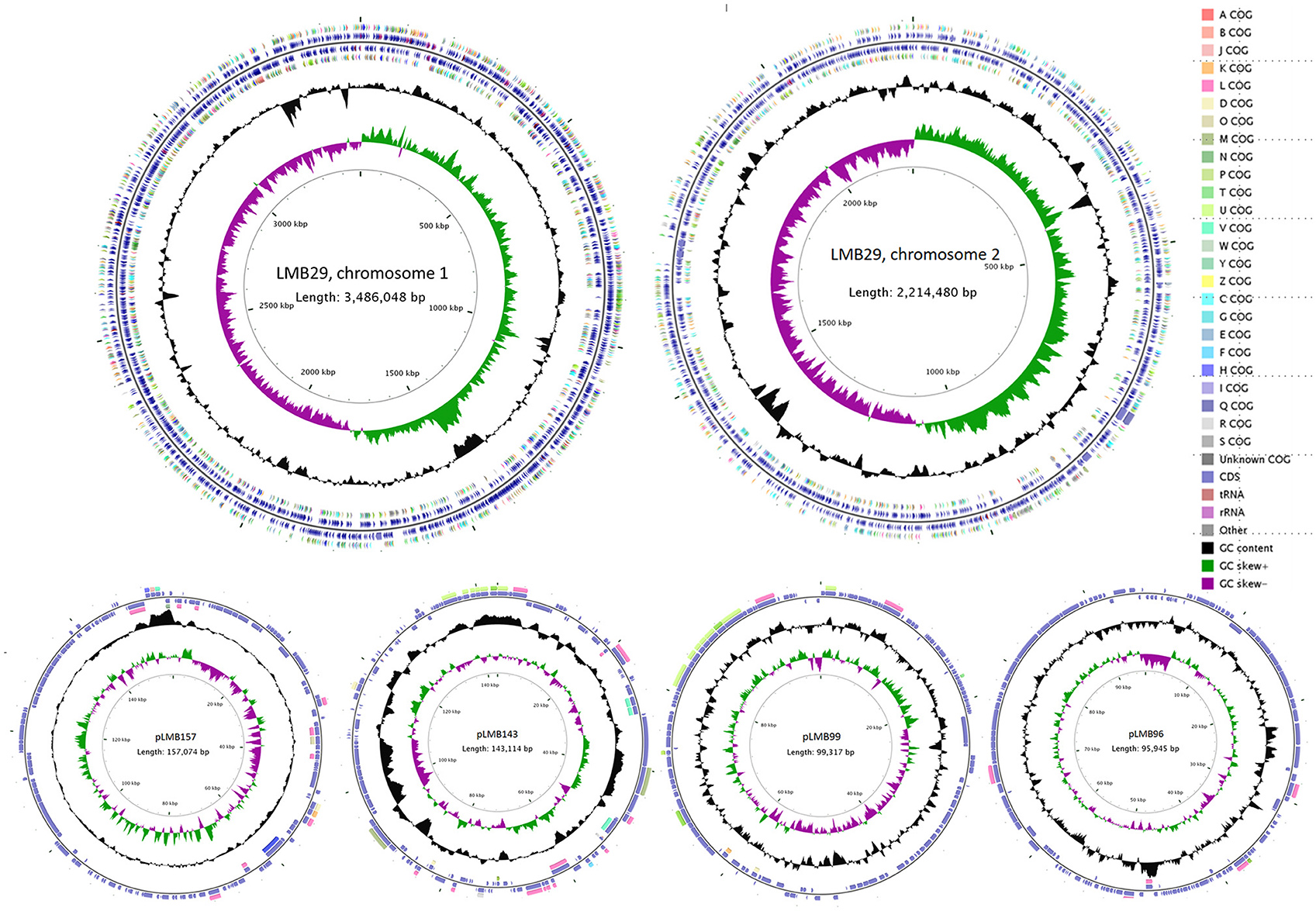
Figure 1. The circular maps of the V. campbellii LMB29. Coding sequences (CDS) were colored into COG family proteins.
The predicted ORFs are further classified into COGs functional groups (2,154 ORFs in total; Figure 2A). According to the COG categorization analysis, based on gene counts, the abundant groups include class of R (486 ORFs, general function prediction only), class of E (363 ORFs, amino acid transport and metabolism), class of S (346 ORFs, function unknown), class of K (339 ORFs, transcription), and class of T (283 ORFs, signal transduction mechanisms; Figure 2A). The genomic sequences were used to against the DEG database to perform gene essentiality analysis. A total of 2,871 ORFs were predicted as essential genes in V. campbellii LMB29 with multiple genes were predicted on genomic islands with horizontal transferability (Supplementary Table 3).
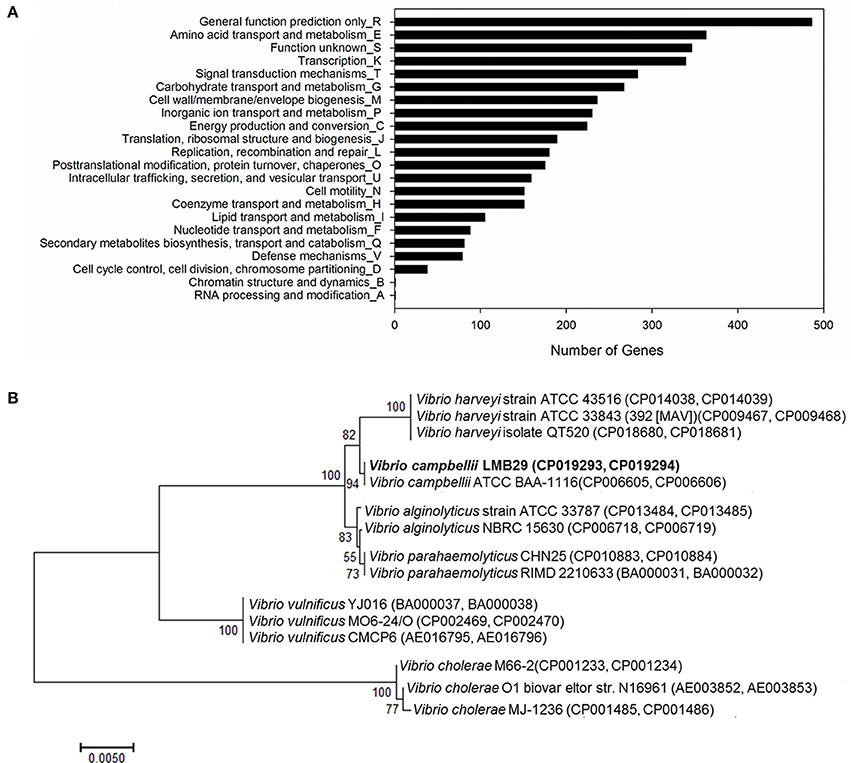
Figure 2. (A) Functional categorization of V. campbellii LMB29 based on the COG database. (B) The phylogenetic tree of the V. campbellii LMB29 with closely related Vibrio species aligned by using ClustalW.
Genome tree analysis was performed on 15 Vibrio species with 16S rRNA sequences alignment and strain LMB29 shows very close phylogenetic distance to V. campbellii ATCC BAA-1116 (Figure 2B). ANI values indicate that strain LMB29 shares a 96.66% similarity with the ATCC strain BAA-1116 based on a 75% AF (average fraction) calculations, but multiple gene rearrangements also happened in the chromosomes (Figure 3). Compared to the single plasmid (~89 kb; NC_022271.1) in V. campbellii ATCC BAA-1116, the V. campbellii LMB29 has a unique plasmid profile with four megaplasmids (Figure 3) which indicates the bacterial evolution of V. campbellii.

Figure 3. Genome alignments for V. campbellii LMB 29 and V. campbellii ATCC BAA-1116 using Mauve. Color blocks in the first genome (V. campbellii LMB29) are connected by lines to similarly colored blocks in the second genome (V. campbellii ATCC BAA-1116). When a block lies above the center line the aligned region is in the forward orientation relative to the first genome sequence. Blocks below the center line indicate regions that align in the reverse complement (inverse) orientation. Regions outside blocks lack detectable homology among the input genomes. Inside each block Mauve draws a similarity profile of the genome sequence. The height of the similarity profile corresponds to the average level of conservation in that region of the genome sequence.
Virulence and Antimicrobial Resistance Genes
The putative virulence factors in V. campbellii LMB29 were analyzed by inquiring the VFDB database (Chen et al., 2016; Table 1). T3SS, which is usually involved in Vibrio pathogenesis, was found on chromosome I. Importantly, the recently identified T6SS (Coulthurst, 2013; Ho et al., 2014) was predicted in strain LMB 29 with T6SS1 (1,649,571–1,672,337 region) on chromosome I, T6SS2 (850,171–881,172 region) and T6SS3 (936,359–959,932 region) on chromosome II (Table 1). T6SSs have been implicated in eukaryotic cell targeting and virulence (Coulthurst, 2013; Ho et al., 2014), and is also believed to have anti-bacterial properties in Vibrio (Church et al., 2016). In addition, the tlh gene encoding a thermolabile hemolysin (TLH) of V. parahaemolyticus was found on chromosome II in strain LMB29. TLH is expressed by all clinical and environmental strains of V. parahaemolyticus (Bej et al., 1999) and it may have similar biological functions similar to these of the TDH (thermostable direct hemolysin) and TRH (TDH-related hemolysin) toxins, playing a key role in Vibrio infections (Wang R. et al., 2015). We also performed LDH release assay using FHM cells (Liu et al., 2016) to test the cytotoxicity activity (Figure 4). Cell death was observed after 3 h post-infection and up to 80% of the cells are lysed within 6 h (Figure 4). Nuclear condensation and fragmentation, based on one DNA staining assay, was confirmed to contribute to the cell death after the infection with V. campbellii LMB29 (Figure 5). Taken together, we conclude here that V. campbellii strain LMB29 is pathogenic which is consistent with our clinical observations in Shenzhen, China.
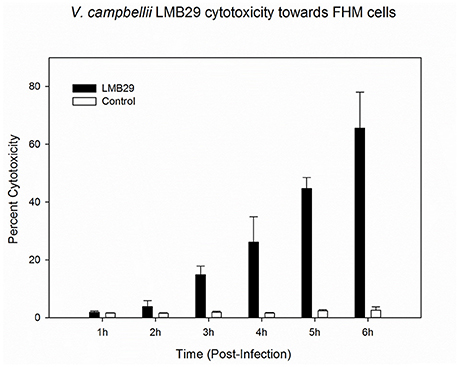
Figure 4. V. campbellii LMB 29 cytotoxicity toward FHM cells. FHM cells were infected with LMB 29 strain or uninfected as described in the Materials and Methods. At the indicated time points, culture supernatants were measured for the release of LDH and calculated as a percentage of total cellular lysis. The data are expressed as means ± SEM from three independent experiments.
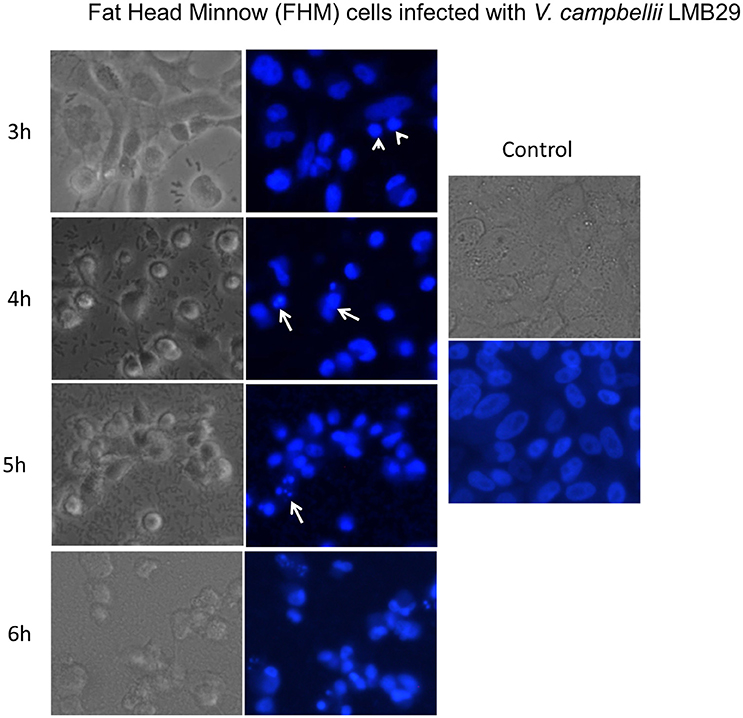
Figure 5. V. campbellii LMB 29 infection induces nuclear fragmentation in FHM cells. FHM cells infected with LMB29 strain or uninfected as described in the Materials and Methods, were stained with Hoechst33258 at indicated time points post-infection. The fluorescence signal was detected under an inverted fluorescence microscope (Leica). Arrows indicate the fragmented nuclei, while arrowheads indicate condensed nuclei.
Thirty-seven genes in V. campbellii LMB29 were observed showing >45% identity to well-characterized antimicrobial resistance genes in reference databases Resfinder and CARD (Table 2). Multiple genes encoding aminoglycoside phosphotransferase [strB, strA and APH(3″)-Ib], tetracycline resistance genes [tet(A), tet35 and tet34] and blaACARB-18 (a beta-lactamase coding gene) were predicted in the LMB29 genome. These results are consistent with our antibiotic susceptibility assay data for strain LMB29 by showing its resistance to ampicillin, amoxicillin, rifampicin, tetracycline, streptomycin, oxacillin, lincomycin, teicoplanin, and vancomycin, some of which are classified as human medically-important antibiotics.
Moreover, in plasmid pLMB157, we named a gene arr-9 which shows 99% identity to a previously described rifampin ADP ribosyltransferase (Arr) (Rodriguez-Blanco et al., 2012). We demonstrated that the arr-9 is responsible for rifampin-resistance phenotype of LMB29 since the deletion mutant was showing susceptibility to rifampin (Figure 6B), and complementation of this gene successfully restored the resistance phenotype (Figure 6). We also constructed the phylogenetic tree for arr-9 with all previously reported rifampin ADP-ribosyltransferase and arr-9 shows a <10% identity to all other genes (Figure 7). This gene was originally reported in integrating conjugative elements (ICEs) in Vibrio splendidus and Vibrio alginolyticus (Rodriguez-Blanco et al., 2012), and the current study is the first report showing its presence in a mobilized plasmid (Figure 8B).
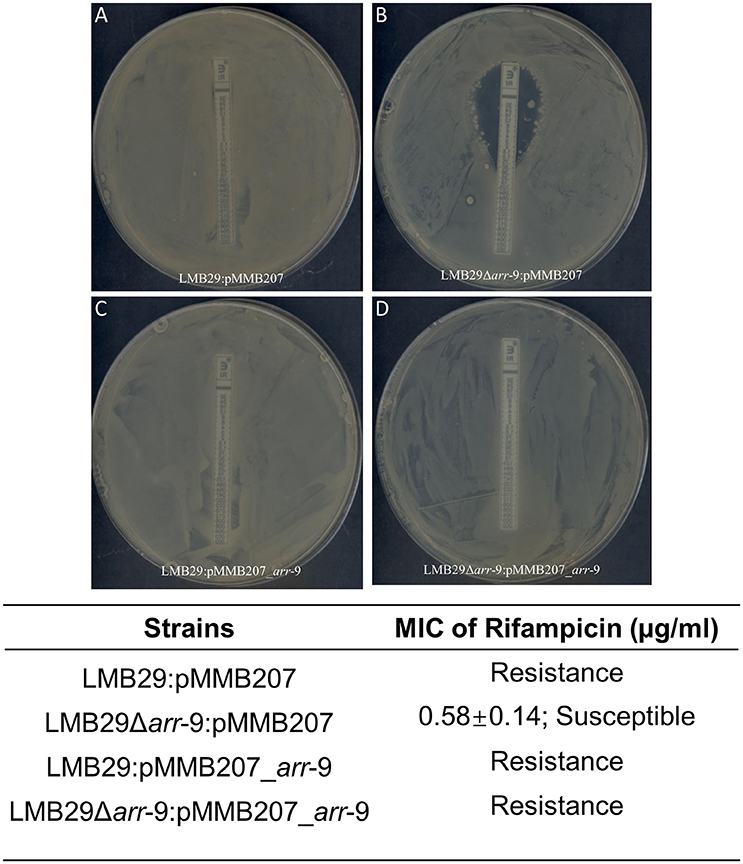
Figure 6. arr-9 is responsible for rifampicin resistance in V. campbellii LMB 29. The assay was performed in triplicates, and representative images were shown in (A–D). MIC of rifampicin are expressed as means ± SEM from three independent experiments.
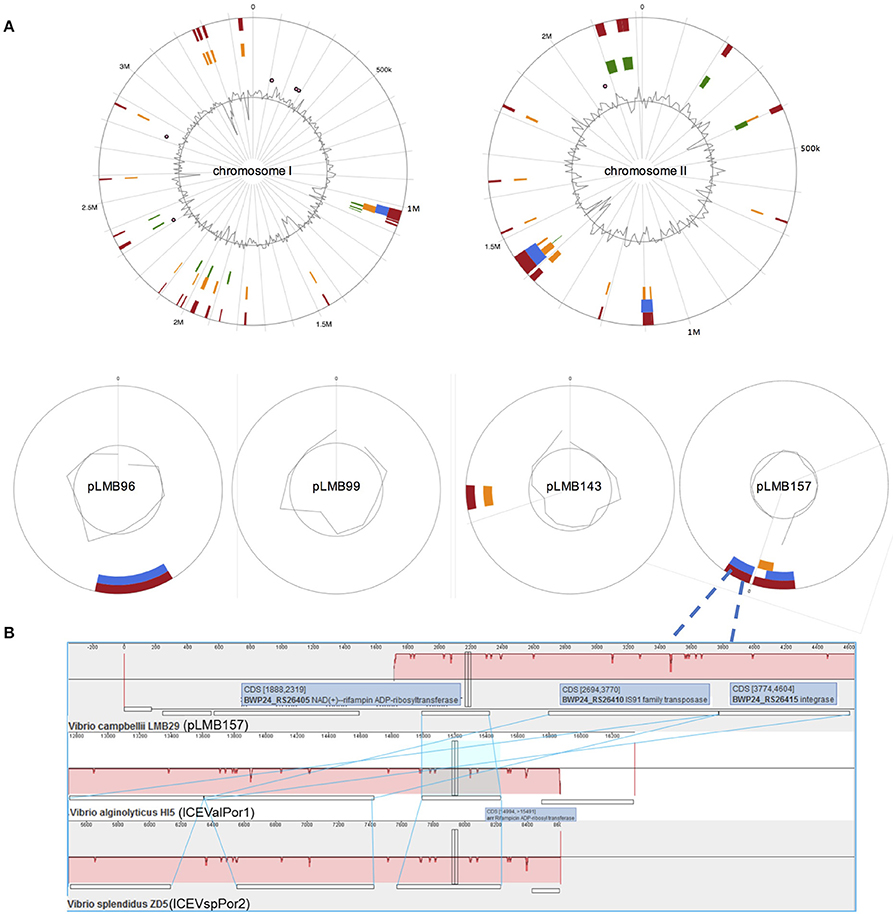
Figure 8. (A) Genomic islands (GI) prediction in V. campbellii LMB29 through IslandViewer 4. The predicted GIs are colored based on the prediction methods. Red indicates an integrated analysis, blue represents IslandPath-DIMOB prediction; orange represents SIGI-HMM and green color indicates IslandPick analysis. (B) The arr-9 gene cassette (arr-9 -transferase-integrase) alignments in V. campbellii LMB29 pLMB157, V. alginolyticus HI5 ICEValPor1, and V. splendidus ZD5 ICEVspPor2.
Genomic islands (GIs), regions of probable horizontal origin, were predicted in V. campbellii LMB29, and multiple GIs were identified in this strain with transferable potentials (Figure 8A; Supplementary Table 3). arr-9 was predicted sits on a 6,844 bp genomic island in pLMB157 which highlights its potential of horizontal transmission (Figure 8A). In addition to arr-9, two aminoglycoside O-phosphotransferase (strA and strB), one sulfonamide-resistant dihydropteroate synthase (sul2) and one tetracycline resistance MFS efflux pump gene [tet(A)] were predicted on another genomic island (7,797 bp) in plasmid pLMB157. These findings are consistent with bacterial adaptations to various environments by acquiring antimicrobial resistance.
Discussion
The complete genome sequence of V. campbellii LMB29 was determined in this study, and the genome (6,283,706 bp) was assembled into two circular chromosomes and four plasmids. Compared with other members of this bacterial species (21 V. campbellii strains available in JGI IMG/MER database, Supplementary Table 1), LMB29 harbors a larger genome with 5,825 predicted genes (Figure 9). The four megaplasmids were believed to contribute to the larger genome size, but their detailed evolutionary benefits need to be further explored. We also assessed the functional profile of LMB29 and other Vibrio spp. based on the COG database, and genome clustering results was shown in hierarchical tress (Figure 10). In general, V. campbellii LMB29 shares similar function profile with other V. campbellii strains, but also includes some pathogenic species (e.g., V. harveyi HY01 and V. parahaemolyticus VIP4-0443) which indicates the pathogenesis of this strain (Figure 10). V. campbellii sits close to V. harveyi and V. vulnificus in the function profiling tree.
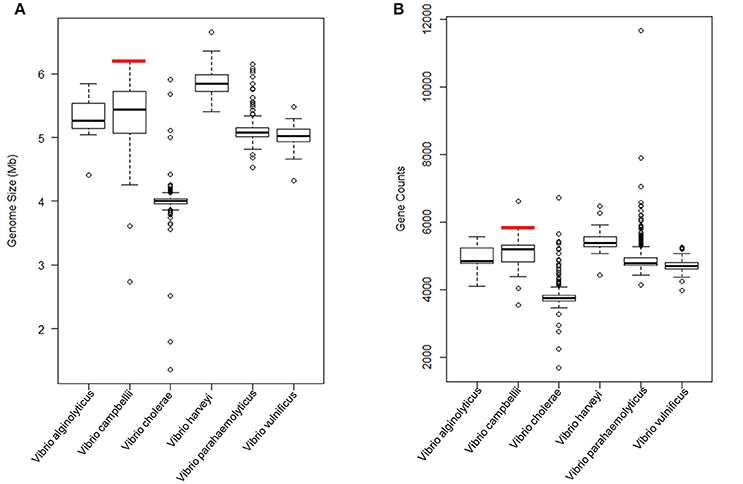
Figure 9. Genome size (A) and gene counts (B) comparisons between V. campbellii LMB29 and other Vibrio spp. (1,045 genomes). Red line indicates V. campbellii LMB29.
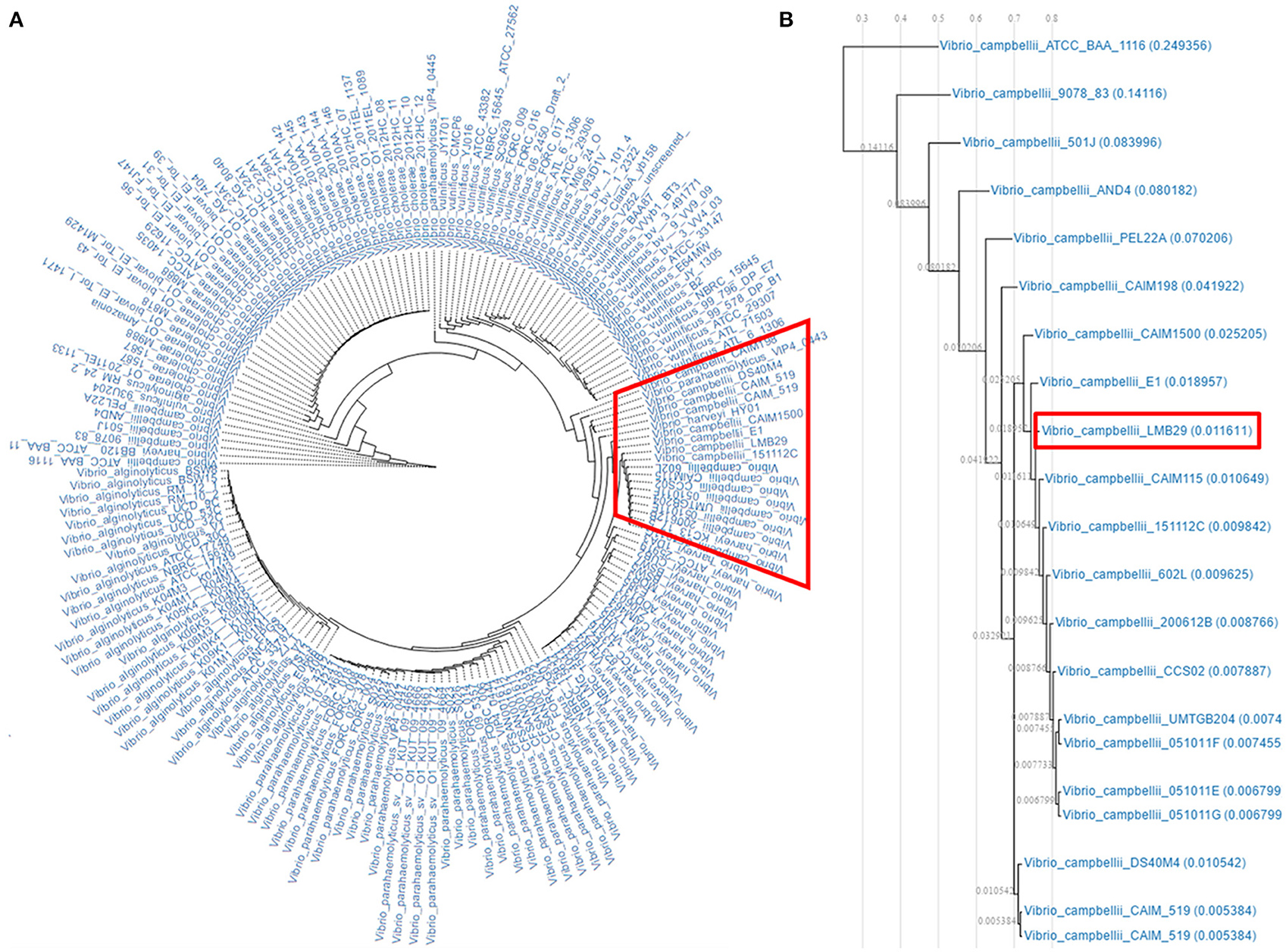
Figure 10. The predicted genome function comparisons between V. campbellii LMB29 and others. (A) Functional profile tree of V. campbellii LMB29 and other Vibrio spp. (B) The functional relationship of V. campbellii LMB29 to other V. campbellii strains.
Vibrio campbellii LMB29 was isolated and studied because of its virulence to red drum in Shenzhen, China. Its cytotoxicity toward fish cells was assessed and confirmed by the LDH assay, and LMB29 infection was shown contributing to the DNA fragmentation (Figure 5). In addition, various virulence factors, two secretion systems (T3SS and T6SS) along with one thermolabile hemolysin encoding gene, tlh, were identified in this strain. These observations are consistent with its pathogenic phenotype which was involved in to serious fish disease in clinics.
Vibrio spp. are usually susceptible to most antimicrobials of veterinary and human significance (Elmahdi et al., 2016). While this V. campbellii LMB29 was showing a multidrug resistance phenotype to at least nine antibiotics we assessed including human medically-important drugs vancomycin and rifampicin. Rifampicin is one of the most potent and broad spectrum antibiotics which are widely used to against bacterial pathogens. Since its introduction in the medical practice, rifampicin has become a front-line drug for treating tuberculosis, leprosy and many other widespread diseases (Alifano et al., 2015). Resistance to rifampicin, a notable global health problem concern, is nearly always due to point mutations in the β-subunit of RNA polymerase in different bacterial species (Goldstein, 2014). However, no change was found in their RNA polymerases of several rifampicin-resistant strains of Vibrio species, including the V. campbellii LMB29, when compared to rifampicin-susceptible strains (data not shown). Interestingly, one gene (BWP24_RS26405), encoding a rifampin ADP-ribosyl transferase, was found in plasmid pLMB157 of V. campbellii LMB29. This gene, we named arr-9, was originally reported in integrating conjugative elements (ICEVspPor2 and ICEValPor1) (Rodriguez-Blanco et al., 2012), and this current study is the first report showing its presence on a transmissible plasmid. We experimentally confirmed the gene function of arr-9 by showing its knock-out mutant loses the resistance phenotype, and the phenotype was restored by overexpressing this gene (Figure 6). This gene arr-9 along with one IS91 family transposase and one integrase were predicted sit on one genomic island which could be easily transmitted, and its dissemination will further compromise the Vibrio infections which will also limit our treatment options (Figure 8).
Overall, we present here the first complete genome of one predominant diseases-causing V. campbellii LMB29. The genome was queried as an effort to study its antimicrobial resistance and to identify potential virulence factors. Multiple resistance genes and virulence factors were predicted in this strain, and we experimentally confirmed its virulence to fish cells and the function of one rifampin ADP-ribosyl transferase encoding gene, arr-9. The high quality complete genome sequences generated in this study will form an important basis for further studies that will lead to a deeper understanding of the molecular mechanisms of Vibrio pathogenesis, thereby improving seafood quality and reducing economic loss.
Data Access
The complete genome sequence of Vibrio campbellii LMB29 has been deposited in GenBank under the accession numbers CP019293 (Chromosome I), CP019294 (Chromosome II), CP019295 (pLMB157), CP019296 (pLMB143), CP019297 (pLMB99), CP019298 (pLMB96).
Author Contributions
JL and ZZ conceived and designed the study, analyzed the data, and wrote the manuscript; JL, YD, YL, CW, PL, and YS performed the experiments and DNA preparation; PL and CH contributed the reagents. All authors read and approved the manuscript for publication.
Conflict of Interest Statement
The authors declare that the research was conducted in the absence of any commercial or financial relationships that could be construed as a potential conflict of interest.
Acknowledgments
This research was supported by the National Natural Science Foundation of China (41276163), the Natural Science Foundation of Jiangsu Province (BK20171431), the Fundamental Research Funds for the Central Universities (2017B03814), the Project of Science and Technology New Star of Zhujiang in Guangzhou city (2013J2200094) and the Natural Science Foundation of Guangdong province (S2011010000232).
Supplementary Material
The Supplementary Material for this article can be found online at: https://www.frontiersin.org/articles/10.3389/fmicb.2017.02035/full#supplementary-material
References
Alifano, P., Palumbo, C., Pasanisi, D., and Tala, A. (2015). Rifampicin-resistance, rpoB polymorphism and RNA polymerase genetic engineering. J. Biotechnol. 202, 60–77. doi: 10.1016/j.jbiotec.2014.11.024
Angiuoli, S. V., Gussman, A., Klimke, W., Cochrane, G., Field, D., Garrity, G., et al. (2008). Toward an online repository of standard operating procedures (SOPs) for (meta)genomic annotation. OMICS 12, 137–141. doi: 10.1089/omi.2008.0017
Bej, A. K., Patterson, D. P., Brasher, C. W., Vickery, M. C., Jones, D. D., and Kaysner, C. A. (1999). Detection of total and hemolysin-producing Vibrio parahaemolyticus in shellfish using multiplex PCR amplification of tl, tdh and trh. J. Microbiol. Methods 36, 215–225. doi: 10.1016/S0167-7012(99)00037-8
Bertelli, C., Laird, M. R., Williams, K. P., Lau, B. Y., Hoad, G., et al. (2017). IslandViewer 4: expanded prediction of genomic islands for larger-scale datasets. Nucleic Acids Res. 45, W30–W35. doi: 10.1093/nar/gkx343
Chen, I. A., Markowitz, V. M., Chu, K., Palaniappan, K., Szeto, E., Pillay, M., et al. (2017). IMG/M: integrated genome and metagenome comparative data analysis system. Nucleic Acids Res. 45, D507–D516. doi: 10.1093/nar/gkw929
Chen, L., Zheng, D., Liu, B., Yang, J., and Jin, Q. (2016). VFDB 2016: hierarchical and refined dataset for big data analysis−10 years on. Nucleic Acids Res. 44, D694–D697. doi: 10.1093/nar/gkv1239
Chin, C. S., Alexander, D. H., Marks, P., Klammer, A. A., Drake, J., Heiner, C., et al. (2013). Nonhybrid, finished microbial genome assemblies from long-read SMRT sequencing data. Nat. Methods 10, 563–569. doi: 10.1038/nmeth.2474
Church, S. R., Lux, T., Baker-Austin, C., Buddington, S. P., and Michell, S. L. (2016). Vibrio vulnificus type 6 secretion system 1 contains anti-bacterial properties. PLoS ONE 11:e0165500. doi: 10.1371/journal.pone.0165500
Coulthurst, S. J. (2013). The type VI secretion system-a widespread and versatile cell targeting system. Res. Microbiol. 164, 640–654. doi: 10.1016/j.resmic.2013.03.017
Darling, A. C., Mau, B., Blattner, F. R., and Perna, N. T. (2004). Mauve: multiple alignment of conserved genomic sequence with rearrangements. Genome Res. 14, 1394–1403. doi: 10.1101/gr.2289704
de la Pena, L. D., Lavilla-Pitogo, C. R., and Paner, M. G. (2001). Luminescent vibrios associated with mortality in pond-cultured shrimp Penaeus monodon in the Philippines: species composition. Fish Pathol. 36, 133–138. doi: 10.3147/jsfp.36.133
Delcher, A. L., Bratke, K. A., Powers, E. C., and Salzberg, S. L. (2007). Identifying bacterial genes and endosymbiont DNA with Glimmer. Bioinformatics 23, 673–679. doi: 10.1093/bioinformatics/btm009
Elmahdi, S., Dasilva, L. V., and Parveen, S. (2016). Antibiotic resistance of Vibrio parahaemolyticus and Vibrio vulnificus in various countries: a review. Food Microbiol. 57, 128–134. doi: 10.1016/j.fm.2016.02.008
Gabriel, M. W., Matsui, G. Y., Friedman, R., and Lovell, C. R. (2014). Optimization of multilocus sequence analysis for identification of species in the genus Vibrio. Appl. Environ. Microbiol. 80, 5359–5365. doi: 10.1128/AEM.01206-14
Goldstein, B. P. (2014). Resistance to rifampicin: a review. J. Antibiot. 67, 625–630. doi: 10.1038/ja.2014.107
Gomez-Gil, B., Soto-Rodriguez, S., Garcia-Gasca, A., Roque, A., Vazquez-Juarez, R., Thompson, F. L., et al. (2004). Molecular identification of Vibrio harveyi-related isolates associated with diseased aquatic organisms. Microbiology 150, 1769–1777. doi: 10.1099/mic.0.26797-0
Gutierrez West, C. K., Klein, S. L., and Lovell, C. R. (2013). High frequency of virulence factor genes tdh, trh, and tlh in Vibrio parahaemolyticus strains isolated from a pristine estuary. Appl. Environ. Microbiol. 79, 2247–2252. doi: 10.1128/AEM.03792-12
Healey, A., Furtado, A., Cooper, T., and Henry, R. J. (2014). Protocol: a simple method for extracting next-generation sequencing quality genomic DNA from recalcitrant plant species. Plant Methods 10:21. doi: 10.1186/1746-4811-10-21
Ho, B. T., Dong, T. G., and Mekalanos, J. J. (2014). A view to a kill: the bacterial type VI secretion system. Cell Host Microbe 15, 9–21. doi: 10.1016/j.chom.2013.11.008
Huntemann, M., Ivanova, N. N., Mavromatis, K., Tripp, H. J., Paez-Espino, D., Palaniappan, K., et al. (2015). The standard operating procedure of the DOE-JGI microbial genome annotation pipeline (MGAP v.4). Stand. Genomic Sci. 10:86. doi: 10.1186/s40793-015-0077-y
Kumar, S., Stecher, G., and Tamura, K. (2016). MEGA7: molecular evolutionary genetics analysis version 7.0 for bigger datasets. Mol. Biol. Evol. 33, 1870–1874. doi: 10.1093/molbev/msw054
Lin, B. C., Wang, Z., Malanoski, A. P., O'grady, E. A., Wimpee, C. F., Vuddhakul, V., et al. (2010). Comparative genomic analyses identify the Vibrio harveyi genome sequenced strains BAA-1116 and HY01 as Vibrio campbellii. Environ. Microbiol. Rep. 2, 81–89. doi: 10.1111/j.1758-2229.2009.00100.x
Liu, J., Lu, S. Y., Orfe, L. H., Ren, C. H., Hu, C. Q., Call, D. R., et al. (2016). ExsE is a negative regulator for T3SS gene expression in Vibrio alginolyticus. Front. Cell. Infect. Microbiol. 6:177. doi: 10.3389/fcimb.2016.00177
Luo, H., Lin, Y., Gao, F., Zhang, C. T., and Zhang, R. (2014). DEG 10, an update of the database of essential genes that includes both protein-coding genes and noncoding genomic elements. Nucleic Acids Res. 42, D574–D580. doi: 10.1093/nar/gkt1131
McArthur, A. G., Waglechner, N., Nizam, F., Yan, A., Azad, M. A., Baylay, A. J., et al. (2013). The comprehensive antibiotic resistance database. Antimicrob. Agents Chemother. 57, 3348–3357. doi: 10.1128/AAC.00419-13
Phuoc, L. H., Corteel, M., Nauwynck, H. J., Pensaert, M. B., Alday-Sanz, V., Van den Broeck, W., et al. (2008). Increased susceptibility of white spot syndrome virus-infected Litopenaeus vannamei to Vibrio campbellii. Environ. Microbiol. 10, 2718–2727. doi: 10.1111/j.1462-2920.2008.01692.x
Rodriguez-Blanco, A., Lemos, M. L., and Osorio, C. R. (2012). Integrating conjugative elements as vectors of antibiotic, mercury, and quaternary ammonium compound resistance in marine aquaculture environments. Antimicrob. Agents Chemother. 56, 2619–2626. doi: 10.1128/AAC.05997-11
Shao, Y.-C. L.-S. C.-T. (2010). The predatory Atlantic red drum, Sciaenops ocellatus, has invaded the western Taiwanese coast in the Indo-West Pacific. Biol. Invasions 12, 1961–1965. doi: 10.1007/s10530-009-9642-x
Tatusov, R. L., Galperin, M. Y., Natale, D. A., and Koonin, E. V. (2000). The COG database: a tool for genome-scale analysis of protein functions and evolution. Nucleic Acids Res. 28, 33–36. doi: 10.1093/nar/28.1.33
Thompson, F. L., Iida, T., and Swings, J. (2004). Biodiversity of vibrios. Microbiol. Mol. Biol. Rev. 68, 403–431. doi: 10.1128/MMBR.68.3.403-431.2004
Thompson, F. L., Thompson, C. C., Naser, S., Hoste, B., Vandemeulebroecke, K., Munn, C., et al. (2005). Photobacterium rosenbergii sp. nov. and Enterovibrio coralii sp. nov., vibrios associated with coral bleaching. Int. J. Syst. Evol. Microbiol. 55, 913–917. doi: 10.1099/ijs.0.63370-0
Walker, B. J., Abeel, T., Shea, T., Priest, M., Abouelliel, A., Sakthikumar, S., et al. (2014). Pilon: an integrated tool for comprehensive microbial variant detection and genome assembly improvement. PLoS ONE 9:e112963. doi: 10.1371/journal.pone.0112963
Wang, L. P., Chen, Y. W., Huang, H., Huang, Z. B., Chen, H., and Shao, Z. Z. (2015). Isolation and identification of Vibrio campbellii as a bacterial pathogen for luminous vibriosis of Litopenaeus vannamei. Aquac. Res. 46, 395–404. doi: 10.1111/are.12191
Wang, R., Zhong, Y., Gu, X., Yuan, J., Saeed, A. F., and Wang, S. (2015). The pathogenesis, detection, and prevention of Vibrio parahaemolyticus. Front. Microbiol. 6:144. doi: 10.3389/fmicb.2015.00144
Keywords: Vibrio campbellii, whole genome sequencing, T6SS, rifampicin resistance, arr-9, virulence, tlh
Citation: Liu J, Zhao Z, Deng Y, Shi Y, Liu Y, Wu C, Luo P and Hu C (2017) Complete Genome Sequence of Vibrio campbellii LMB 29 Isolated from Red Drum with Four Native Megaplasmids. Front. Microbiol. 8:2035. doi: 10.3389/fmicb.2017.02035
Received: 26 June 2017; Accepted: 05 October 2017;
Published: 23 October 2017.
Edited by:
Rakesh Sharma, Institute of Genomics and Integrative Biology (CSIR), IndiaReviewed by:
Seong Woon Roh, World Institute of Kimchi (WIKIM), South KoreaHao Luo, Tianjin University, China
Copyright © 2017 Liu, Zhao, Deng, Shi, Liu, Wu, Luo and Hu. This is an open-access article distributed under the terms of the Creative Commons Attribution License (CC BY). The use, distribution or reproduction in other forums is permitted, provided the original author(s) or licensor are credited and that the original publication in this journal is cited, in accordance with accepted academic practice. No use, distribution or reproduction is permitted which does not comply with these terms.
*Correspondence: Zhe Zhao, emhlemhhb0BoaHUuZWR1LmNu
 Jinxin Liu
Jinxin Liu Zhe Zhao
Zhe Zhao Yiqing Deng3
Yiqing Deng3 Peng Luo
Peng Luo